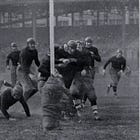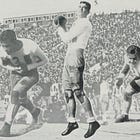Observations on Canadian Football in 1931
The differences in rules between American and Canadian football are fascinating because the two nations played and still play highly similar games under somewhat different rules, with both sets being arbitrary. As Canadian Rugby evolved toward the American game, they adopted some American rules, while going their own way on others.
Canadian rugby or football first allowed the forward pass in 1929, though only the western provinces approved it. Western football led other forward-passing changes over the next decade as the Eastern traditionalists stuck to their old-school, rugby-oriented game, but the Easterners lost the battle and the war.
An interesting difference between the Canadian and American games was that pro football gained prominence in the U.S. earlier than in Canada. Canada’s top senior teams remained amateurish through WWII so university and senior teams faced one another for the Grey Cup through 1953, after which, only professional teams drank from the cup.
A short video of a 1931 Grey Cup playoff game between the University of Western Ontario and the Sarnia Imperials, a senior team, included a few elements that caught my eye.
The video is 3 minutes and 40 seconds long, so watch the whole thing or skip to the noted time stamps.
The first item comes at 0:18 and relates to the triangular hatching between the 20 and 25-yard lines. (You will see the markings throughout the video.) I had no idea what the marking designated, but a little investigating showed that Canada's early passing rules prohibited passes thrown over the defending team's 25-yard line. Ground crews distinguished the 5-yard areas inside the 25-yard lines to make it easier for the officials running around the field to identify passes crossing the 25-yard line.
The hatching makes sense and is akin to when American football began decorating end zones after the goal posts moved to the end line in 1927.
Continue forward to the kickoff at the 0:30 mark. The kick returner catches the ball at the 15-yard line, and runs forward about 15 yards before punting aka return kicking the ball back to the kicking team. The opposing team retrieves it at the 30-yard line.
The return kick originated in rugby and reflected that game's emphasis on field position over possession. American football became increasingly possession-oriented as offenses and the passing game developed, but the use of the return kick in a Grey Cup playoff game tells you where Canadian football was at in the first few years after implementing the forward pass. The return kick remains legal in Canadian football, though it mostly occurs in the end zone to avoid a rouge. American college football allowed the return kick until 1967, but it was little used by then.
The Canadian game in 1931 emphasized ad hoc laterals more than is seen on either side of the border today. You can see laterals on a punt return at 1:30, an option-like lateral at 1:36, and another at 1:45.
I love the pre-snap movement in today’s Canadian game, and its 1931 analog is on display at 2:20. It occurs from a tight formation and resembles the backfield movement and misdirection of the 1930s American game.
A final note concerns the guy catching the pass on the same play that starts at 2:20. He wears short pants. Short pants go back much longer than most fans realize, though old-time Canadian short pants resembled hockey pants more than their American counterparts.
That's it for now. Let me know if you spot anything else in the video.
Also, remember that the first CFL exhibition game is less than four months away, as Calgary visits BC on May 19.
Click here for options on how to support this site beyond a free subscription.



